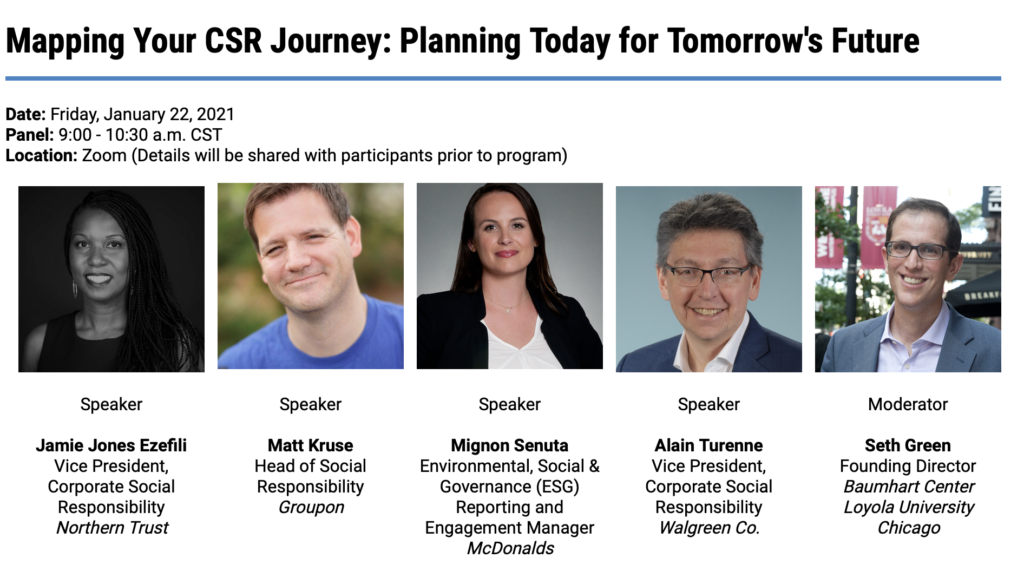As a result of the pandemic and current social justice movements, an increasing number of consumers and employees see social impact as important and 64% of millennials say they will not take a job if the company doesn’t have any corporate social responsibility practices, underscoring, more than ever, that a solid CSR strategy is becoming increasingly essential to a company’s success.
“If you’re a company that wants talent, and you want customers and you want investors, you need to consider your purpose very carefully, because all of these constituencies are looking,” said Seth Green, the founding director of Baumhart Center at Loyola University Chicago, during a panel discussion hosted by The Executives’ Club of Chicago on January 22.
The discussion, titled “Mapping Your CSR Journey: Planning Today for Tomorrow’s Future,” featured a panel comprised of corporate social responsibility leaders Jamie Jones Ezefili from Northern Trust, Matt Kruse from Groupon, Mignon Senuta from McDonalds, and Alain Turenne from Walgreen Co., with Green as moderator.

Green began with a presentation discussing the four stages of corporate social responsibility — compliance, philanthropy, responsibility and purpose. Steps two through four “focus on social and environmental value creation across the enterprise,” Green said.
The ideal most companies are striving for with their CSR strategy is the fourth level of the framework. This is where strategic integration happens and companies are approaching decisions from a standpoint that integrates profit and purpose.
All four panelists cited principles and values their company’s CSR strategy adheres to that guide their business decisions.

Alain Turenne, Vice President of Corporate Social Responsibility at Walgreens Co., talked about four pillars: healthy community, sustainable marketplace, healthy and inclusive workplace and healthy planet. In 2020, Walgreens centered Covid-19 and racial equity in their strategy.
For Jamie Jones Ezefili, Vice President of Corporate Responsibility of Northern Trust, their strategy focuses on diversity, equity and inclusion, community engagement, environmental impacts and sustainable investing. Going forward, they want to be more transparent and focus on letting people know how they can support them upfront.
At McDonalds, ESG Reporting and Engagement Manager Mignon Senuta uses three buckets when thinking about ESG metrics. The first is connecting to the core of who they are as a company. The second is identifying and prioritizing their material issues with input from stakeholders and internal risk assessments and analyses. The last bucket is keeping their finger on the pulse with regulatory and reputational drivers.
As the Head of Social Responsibility at Groupon, Matt Kruse focuses on building amazing communities through neighborhood work done with the merchants on their platform. Groupon does this with a hyperlocal portfolio.
For those new to CSR or those looking to improve their company’s corporate social responsibility, here are six tips for assembling a comprehensive CSR strategy.
1. Ensure engagement at all levels of the organization
An essential part of CSR is making sure the strategy is consistent with the makeup of the company and satisfies various stakeholders. Walgreens’ business resource groups represent various constituents within the company and allow them to ensure that their actions match what the employees believe, Turenne said.
2. Bring in expertise
Conversations with different people allow more learning to take place and help companies continue to progress. Walgreens has an external advisory board created for the U.S. business made up of experts in various aspects of CSR.
3. Understand your business
According to Ezefili, it is important to understand what the sole responsibility and purpose of your business or corporation is. For Northern Trust, it’s vital to think about how the company makes money, how it loses money, what clients need, and what different stakeholders in the community need, Ezefili said. Then they combine those principles with a business mindset to see how to make an impact.
4. Don’t try to accomplish everything at once
Sometimes, it is necessary to consider what the company needs to do in the current moment and what it can tackle in five years, Ezefili said. Additionally, instead of a single company undertaking responsibilities by itself, partnering can help businesses accomplish more goals.
5. Focus on risk assessments
“Ongoing enterprise risk management, scenario modeling and climate scenario modeling are all important for companies that are looking to integrate ESG more into the business, and have metrics that are really going to demonstrate that resilience,” Senuta said. Depending on where and how the business operates, it can assess risk through a global lens or a hyperlocal lens.
6. Prioritize culture
“When you’re paying attention to that culture, aligning with it, activating it and energizing it with the work you do in CSR, I think that’s where the big differences are made and where success has really happened,” Kruse said.
More from Better:
- Better Makers: Chicago History Museum’s ‘Making History Awards’ Honor the Lasting Impact of Chicago Leaders
- 10 Major Medical Breakthroughs — and What They Could Mean for You
- Forces for Change: Meet 6 Leaders Making Chicago and the Suburbs Better
 Aliyah Armstrong is an intern at Better with a passion for arts and entertainment reporting. A senior in Northwestern’s Medill School of Journalism, she is also minoring in Sociological Studies. Aliyah supports the Greater Chicago Food Depository and Black Youth Project 100, an organization that aims to create justice and freedom for all Black people.
Aliyah Armstrong is an intern at Better with a passion for arts and entertainment reporting. A senior in Northwestern’s Medill School of Journalism, she is also minoring in Sociological Studies. Aliyah supports the Greater Chicago Food Depository and Black Youth Project 100, an organization that aims to create justice and freedom for all Black people.

